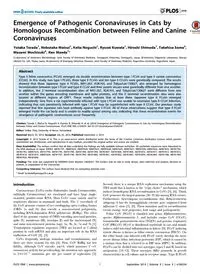
2014 Emergence of Pathogenic Coronaviruses in Cats by Homologous Recombination between Feline and Canine Coronaviruses PDF
Preview 2014 Emergence of Pathogenic Coronaviruses in Cats by Homologous Recombination between Feline and Canine Coronaviruses
Emergence of Pathogenic Coronaviruses in Cats by Homologous Recombination between Feline and Canine Coronaviruses Yutaka Terada1, Nobutaka Matsui1, Keita Noguchi1, Ryusei Kuwata1, Hiroshi Shimoda1, Takehisa Soma2, Masami Mochizuki3, Ken Maeda1* 1 Laboratory of Veterinary Microbiology, Joint Faculty of Veterinary Medicine, Yamaguchi University, Yamaguchi, Japan, 2 Veterinary Diagnostic Laboratory, Marupi Lifetech Co. Ltd., Osaka, Japan, 3 Laboratory of Emerging Infectious Diseases, Joint Faculty of Veterinary Medicine, Kagoshima University, Kagoshima, Japan Abstract Type II feline coronavirus (FCoV) emerged via double recombination between type I FCoV and type II canine coronavirus (CCoV). In this study, two type I FCoVs, three type II FCoVs and ten type II CCoVs were genetically compared. The results showed that three Japanese type II FCoVs, M91-267, KUK-H/L and Tokyo/cat/130627, also emerged by homologous recombination between type I FCoV and type II CCoV and their parent viruses were genetically different from one another. In addition, the 39-terminal recombination sites of M91-267, KUK-H/L and Tokyo/cat/130627 were different from one another within the genes encoding membrane and spike proteins, and the 59-terminal recombination sites were also located at different regions of ORF1. These results indicate that at least three Japanese type II FCoVs emerged independently. Sera from a cat experimentally infected with type I FCoV was unable to neutralize type II CCoV infection, indicating that cats persistently infected with type I FCoV may be superinfected with type II CCoV. Our previous study reported that few Japanese cats have antibody against type II FCoV. All of these observations suggest that type II FCoV emerged inside the cat body and is unable to readily spread among cats, indicating that these recombination events for emergence of pathogenic coronaviruses occur frequently. Citation: Terada Y, Matsui N, Noguchi K, Kuwata R, Shimoda H, et al. (2014) Emergence of Pathogenic Coronaviruses in Cats by Homologous Recombination between Feline and Canine Coronaviruses. PLoS ONE 9(9): e106534. doi:10.1371/journal.pone.0106534 Editor: Volker Thiel, University of Berne, Switzerland Received March 20, 2014; Accepted July 30, 2014; Published September 2, 2014 Copyright: � 2014 Terada et al. This is an open-access article distributed under the terms of the Creative Commons Attribution License, which permits unrestricted use, distribution, and reproduction in any medium, provided the original author and source are credited. Data Availability: The authors confirm that all data underlying the findings are fully available without restriction. All nucleotide sequences were deposited to the DNA database of Japan (DDBJ). AB781791, AB907625, AB907626, AB907627, AB907628, AB907629, AB907631, AB907630, AB907632, AB907633, AB781792, AB781793, AB907634, AB781794, AB781795, AB781790, AB781788, AB781789, AB781807, AB781808, AB781809, AB781810, AB781811, AB781812, AB781813, AB781814, AB781815, AB907624, AB781797, AB781798, AB781799, AB781800, AB781801, AB781802, AB781803, AB781804, AB781805, AB781788, AB781789, AB907624, AB781806. Funding: This work was supported by KAKENHI Grant Number 24658257. The funders had no role in study design, data collection and analysis, decision to publish, or preparation of the manuscript. Competing Interests: The authors have declared that no competing interests exist. * Email:
